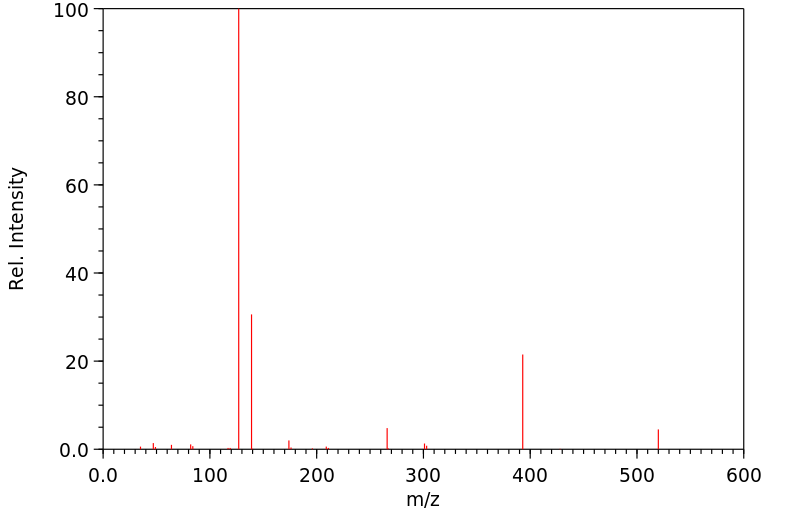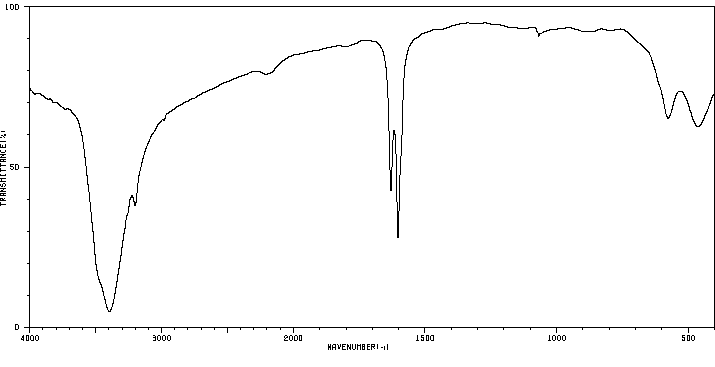四碘甲烷 | 507-25-5
中文名称
四碘甲烷
中文别名
四碘化碳
英文名称
carbon tetraiodide
英文别名
tetraiodmethan;Tetrajod-methan;tetraiodomethane;Tetraiodkohlenstoff;Tetrajodkohlenstoff
CAS
507-25-5
化学式
CI4
mdl
MFCD00001067
分子量
519.629
InChiKey
JOHCVVJGGSABQY-UHFFFAOYSA-N
BEILSTEIN
——
EINECS
——
-
物化性质
-
计算性质
-
ADMET
-
安全信息
-
SDS
-
制备方法与用途
-
上下游信息
-
文献信息
-
表征谱图
-
同类化合物
-
相关功能分类
-
相关结构分类
物化性质
-
熔点:168 °C (dec.) (lit.)
-
沸点:329.2°C (rough estimate)
-
密度:4.50 g/cm3 (0℃)
-
保留指数:1862;1862
-
稳定性/保质期:
按规格使用和贮存,不会发生分解,并应避免与氧化物接触。
计算性质
-
辛醇/水分配系数(LogP):3.3
-
重原子数:5
-
可旋转键数:0
-
环数:0.0
-
sp3杂化的碳原子比例:1.0
-
拓扑面积:0
-
氢给体数:0
-
氢受体数:0
安全信息
-
危险等级:6.1
-
危险品标志:Xi
-
安全说明:S26,S36
-
危险类别码:R20/21/22,R36/37/38
-
WGK Germany:3
-
危险品运输编号:2811
-
RTECS号:FG4960000
-
海关编码:2827600000
-
包装等级:III
-
危险类别:6.1
-
储存条件:2-8°C条件下,应将物品储存于阴凉、干燥且通风良好的库房内。远离火种和热源,并避免阳光直射。包装需密封保存,与酸类及食用化学品分开存放,严禁混合储存。同时,在储区备有合适的材料以处理可能的泄漏情况。
SDS
模块 1. 化学品
1.1 产品标识符
: 四碘甲烷
产品名称
1.2 鉴别的其他方法
Carbon tetraiodide
1.3 有关的确定了的物质或混合物的用途和建议不适合的用途
仅用于研发。不作为药品、家庭或其它用途。
模块 2. 危险性概述
2.1 GHS-分类
皮肤刺激 (类别 2)
眼睛刺激 (类别 2A)
特异性靶器官系统毒性(一次接触) (类别 3)
2.2 GHS 标记要素,包括预防性的陈述
象形图
警示词 警告
危险申明
H315 造成皮肤刺激。
H319 造成严重眼刺激。
H335 可能引起呼吸道刺激。
警告申明
预防措施
P261 避免吸入粉尘/烟/气体/烟雾/蒸气/喷雾.
P264 操作后彻底清洁皮肤。
P271 只能在室外或通风良好之处使用。
P280 穿戴防护手套/ 眼保护罩/ 面部保护罩。
事故响应
P302 + P352 如果皮肤接触:用大量肥皂和水清洗。
P304 + P340 如吸入: 将患者移到新鲜空气处休息,并保持呼吸舒畅的姿势。
P305 + P351 + P338 如与眼睛接触,用水缓慢温和地冲洗几分钟。如戴隐形眼镜并可方便地取
出,取出隐形眼镜,然后继续冲洗.
P312 如感觉不适,呼救中毒控制中心或医生.
P321 具体处置(见本标签上提供的急救指导)。
P332 + P313 如觉皮肤刺激:求医/就诊。
P337 + P313 如仍觉眼睛刺激:求医/就诊。
P362 脱掉沾污的衣服,清洗后方可再用。
安全储存
P403 + P233 存放于通风良的地方。 保持容器密闭。
P405 存放处须加锁。
废弃处置
P501 将内容物/ 容器处理到得到批准的废物处理厂。
2.3 其它危害物 - 无
模块 3. 成分/组成信息
3.1 物 质
: Carbon tetraiodide
别名
: CI4
分子式
: 519.63 g/mol
分子量
组分 浓度或浓度范围
Tetraiodomethane
-
化学文摘登记号(CAS 507-25-5
No.) 208-068-5
EC-编号
模块 4. 急救措施
4.1 必要的急救措施描述
一般的建议
请教医生。 向到现场的医生出示此安全技术说明书。
吸入
如果吸入,请将患者移到新鲜空气处。 如呼吸停止,进行人工呼吸。 请教医生。
皮肤接触
用肥皂和大量的水冲洗。 请教医生。
眼睛接触
用大量水彻底冲洗至少15分钟并请教医生。
食入
切勿给失去知觉者通过口喂任何东西。 用水漱口。 请教医生。
4.2 主要症状和影响,急性和迟发效应
据我们所知,此化学,物理和毒性性质尚未经完整的研究。
4.3 及时的医疗处理和所需的特殊处理的说明和指示
无数据资料
模块 5. 消防措施
5.1 灭火介质
灭火方法及灭火剂
用水雾,抗乙醇泡沫,干粉或二氧化碳灭火。
5.2 源于此物质或混合物的特别的危害
碳氧化物, 碘化氢
5.3 给消防员的建议
如必要的话,戴自给式呼吸器去救火。
5.4 进一步信息
无数据资料
模块 6. 泄露应急处理
6.1 作业人员防护措施、防护装备和应急处置程序
使用个人防护用品。 避免粉尘生成。 避免吸入蒸气、烟雾或气体。 保证充分的通风。
人员疏散到安全区域。 避免吸入粉尘。
6.2 环境保护措施
不要让产品进入下水道。
6.3 泄漏化学品的收容、清除方法及所使用的处置材料
收集和处置时不要产生粉尘。 扫掉和铲掉。 放入合适的封闭的容器中待处理。
6.4 参考其他部分
丢弃处理请参阅第13节。
模块 7. 操作处置与储存
7.1 安全操作的注意事项
避免接触皮肤和眼睛。 避免形成粉尘和气溶胶。
在有粉尘生成的地方,提供合适的排风设备。一般性的防火保护措施。
7.2 安全储存的条件,包括任何不兼容性
贮存在阴凉处。 使容器保持密闭,储存在干燥通风处。
建议的贮存温度: 2 - 8 °C
充气操作和储存
7.3 特定用途
无数据资料
模块 8. 接触控制和个体防护
8.1 容许浓度
最高容许浓度
没有已知的国家规定的暴露极限。
8.2 暴露控制
适当的技术控制
根据良好的工业卫生和安全规范进行操作。 休息前和工作结束时洗手。
个体防护设备
眼/面保护
带有防护边罩的安全眼镜符合 EN166要求请使用经官方标准如NIOSH (美国) 或 EN 166(欧盟)
检测与批准的设备防护眼部。
皮肤保护
戴手套取 手套在使用前必须受检查。
请使用合适的方法脱除手套(不要接触手套外部表面),避免任何皮肤部位接触此产品.
使用后请将被污染过的手套根据相关法律法规和有效的实验室规章程序谨慎处理. 请清洗并吹干双手
所选择的保护手套必须符合EU的89/686/EEC规定和从它衍生出来的EN 376标准。
身体保护
防渗透的衣服, 防护设备的类型必须根据特定工作场所中的危险物的浓度和数量来选择。
呼吸系统防护
如须暴露于有害环境中,请使用P95型(美国)或P1型(欧盟 英国
143)防微粒呼吸器。如需更高级别防护,请使用OV/AG/P99型(美国)或ABEK-P2型 (欧盟 英国 143)
防毒罐。
呼吸器使用经过测试并通过政府标准如NIOSH(US)或CEN(EU)的呼吸器和零件。
模块 9. 理化特性
9.1 基本的理化特性的信息
a) 外观与性状
形状: 结晶
颜色: 深紫色
b) 气味
无数据资料
c) 气味阈值
无数据资料
d) pH值
无数据资料
e) 熔点/凝固点
熔点/凝固点: 168 °C - 分解
f) 沸点、初沸点和沸程
无数据资料
g) 闪点
无数据资料
h) 蒸发速率
无数据资料
i) 易燃性(固体,气体)
无数据资料
j) 高的/低的燃烧性或爆炸性限度 无数据资料
k) 蒸气压
无数据资料
l) 蒸汽密度
无数据资料
m) 密度/相对密度
无数据资料
n) 水溶性
无数据资料
o) n-辛醇/水分配系数
无数据资料
p) 自燃温度
无数据资料
q) 分解温度
无数据资料
r) 粘度
无数据资料
模块 10. 稳定性和反应活性
10.1 反应性
无数据资料
10.2 稳定性
无数据资料
10.3 危险反应
无数据资料
10.4 应避免的条件
无数据资料
10.5 不相容的物质
强氧化剂
10.6 危险的分解产物
其它分解产物 - 无数据资料
模块 11. 毒理学资料
11.1 毒理学影响的信息
急性毒性
无数据资料
皮肤刺激或腐蚀
无数据资料
眼睛刺激或腐蚀
无数据资料
呼吸道或皮肤过敏
无数据资料
生殖细胞致突变性
无数据资料
致癌性
IARC:
此产品中没有大于或等于 0。1%含量的组分被 IARC鉴别为可能的或肯定的人类致癌物。
生殖毒性
无数据资料
特异性靶器官系统毒性(一次接触)
吸入 - 可能引起呼吸道刺激。
特异性靶器官系统毒性(反复接触)
无数据资料
吸入危险
无数据资料
潜在的健康影响
吸入 吸入可能有害。 引起呼吸道刺激。
摄入 如服入是有害的。
皮肤 通过皮肤吸收可能有害。 造成皮肤刺激。
眼睛 造成严重眼刺激。
接触后的征兆和症状
据我们所知,此化学,物理和毒性性质尚未经完整的研究。
附加说明
化学物质毒性作用登记: FG4960000
模块 12. 生态学资料
12.1 生态毒性
无数据资料
12.2 持久性和降解性
无数据资料
12.3 潜在的生物累积性
无数据资料
12.4 土壤中的迁移性
无数据资料
12.5 PBT 和 vPvB的结果评价
无数据资料
12.6 其它不良影响
无数据资料
模块 13. 废弃处置
13.1 废物处理方法
产品
将剩余的和不可回收的溶液交给有许可证的公司处理。
联系专业的拥有废弃物处理执照的机构来处理此物质。
与易燃溶剂相溶或者相混合,在备有燃烧后处理和洗刷作用的化学焚化炉中燃烧
受污染的容器和包装
按未用产品处置。
模块 14. 运输信息
14.1 联合国危险货物编号
欧洲陆运危规: - 国际海运危规: - 国际空运危规: -
14.2 联合国运输名称
欧洲陆运危规: 非危险货物
国际海运危规: 非危险货物
国际空运危规: 非危险货物
14.3 运输危险类别
欧洲陆运危规: - 国际海运危规: - 国际空运危规: -
14.4 包裹组
欧洲陆运危规: - 国际海运危规: - 国际空运危规: -
14.5 环境危险
欧洲陆运危规: 否 国际海运危规 国际空运危规: 否
海洋污染物(是/否): 否
14.6 对使用者的特别提醒
无数据资料
上述信息视为正确,但不包含所有的信息,仅作为指引使用。本文件中的信息是基于我们目前所知,就正
确的安全提示来说适用于本品。该信息不代表对此产品性质的保证。
参见发票或包装条的反面。
模块 15 - 法规信息
N/A
模块16 - 其他信息
N/A
制备方法与用途
用途:用于有机合成。
上下游信息
反应信息
-
作为反应物:参考文献:名称:Bellino, F., Gazzetta Chimica Italiana, 1932, vol. 62, p. 795 - 798摘要:DOI:
-
作为产物:参考文献:名称:Kretow; Melnikow, Zhurnal Obshchei Khimii, 1932, vol. 2, p. 202,206摘要:DOI:
-
作为试剂:描述:甲基-6-O-三苯基甲基-alpha-D-吡喃葡萄糖苷 在 吡啶 、 4-二甲氨基吡啶 、 sodium hydroxide 、 sodium tetrahydroborate 、 cerium(III) chloride 、 R-Alpine-Hydride 、 四碘甲烷 、 3 A molecular sieve 、 三氟化硼乙醚 、 四丁基溴化铵 、 双氧水 、 sodium hydride 、 二正丁基氧化锡 、 对甲苯磺酸 、 甲基磺酰氯 、 间氯过氧苯甲酸 、 三苯基膦 、 pyridinium chlorochromate 、 mercury dichloride 作用下, 以 甲醇 、 二氯甲烷 、 N,N-二甲基甲酰胺 、 乙腈 为溶剂, 反应 111.17h, 生成 2-O-Allyl-3,4,5-tri-O-benzyl-6-O-(p-methoxybenzyl)-myo-inositol参考文献:名称:An Effective Strategy for the Synthesis of 6-O-(2-Amino-2-deoxy-.alpha.-D-glucopyranosyl)-D-chiro- and -D-myo-inositol 1-Phosphate Related to Putative Insulin Mimetics摘要:Two glycosylinositol phosphates related to putative insulin mimetics, 6-O-(2-amino-2-deoxy-alpha-D-glucopyranosyl)-D-chiro-inositol 1-phosphate (1) and 6-O-(2-amino-2-deoxy-alpha-D-glucopyranosyl)-D-myo-inositol 1-phosphate (2), have been synthesized from selectively protected and enantiomerically pure D-chiro- and myo-inositol derivatives. The D-chiro-inositol unit was prepared in a multigram scale from D-glucose using the Ferrier's carbocyclization route, and it was transformed into the corresponding myo epimer by an oxidation-reduction sequence. The trichloroacetimidate method was applied efficiently for the key glycosylation of the inositol derivatives.DOI:10.1021/jo00090a035
文献信息
-
Preparation, ligand-exchange reactions, and alkylation reactions of some carbon disulphide derivatives of iron作者:Paul Conway、Seamus M. Grant、A. R. ManningDOI:10.1039/dt9790001920日期:——which may be polynuclear. When L = CNMe or CNBut further reaction occurs to give [Fe(CO)L3(CS2)] and then a carbonyl-free complex. Ligand-exchange reactions of the complexes where L = PPh3 or P(OPh)3 with the phosphorus(III) ligands L′ gives [Fe(CO)2L(L′)(CS2)] rapidly and then [Fe(CO)2L′2(CS2)] much more slowly. The extent of this reaction depends on ligand size and is more complete for the less bulky许多的[Fe(CO)2大号2(η 2 -CS 2复合物已从[铁制备)] 2(CO)9 ]和L CS 2溶液[L = PR 3,P(OR)3,或CNR]。当L = P(OMe)3时,分离出第二不稳定产物,其可能是多核的。当L = CNME或CNBu吨进一步发生反应,得到的[Fe(CO)L- 3(CS 2)],然后一个复杂的自由羰基。L = PPh 3或P(OPh)3与磷(III)配体L'的配合物的配体交换反应得到[Fe(CO)2 L(L')(CS 2)]迅速,然后[Fe(CO) 2 L' 2(CS 2)]缓慢得多。该反应的程度取决于配体的大小,并且对于较小体积的L'而言更完整。但是,配体的碱性也非常重要,因此L'= AsBu n 3仅置换一个L = P(OPh) 3,而对于L'= SbEt 3则该反应是不完全的。另一方面,非常笨重但基本的L'= PPr i 3将完全取代较小笨重但基本L = P(OPh)
-
Optically active transition-metal complexes VII Iron and ruthenium complexes with the optically active cyclopentadienyl ligand PCp: syntheses and ligand exchange reactions作者:Bernhard Pfister、Ruedi Stauber、Albrecht SalzerDOI:10.1016/s0022-328x(96)06849-0日期:1997.4The optically active complexes [PCpFe(CO)2]2 and [PCpRu(CO)2]2 (PCp = pinene-fused cyclopentadiene) have been converted into half-sandwich complexes PCpM(CO)2X (XCl, Br, I, CH3, COMe, COPh, COMes) by either oxidative or reductive methods. Ligand exchange of one of the diastereotopic carbonyl ligands for a Lewis base L L = tertiary phosphine or phosphite) generates diastereomeric complexes PCpML(CO)X旋光配合物[PCpFe(CO)2 ] 2和[PCpRu(CO)2 ] 2(PCp = pin烯稠合的环戊二烯)已转化为半三明治复合物PCpM(CO)2 X(XCl,Br, I,CH 3,COMe,COPh,COMes)通过氧化或还原方法。Lewis碱LL =叔膦或亚磷酸酯的非对映体羰基配体之一的配体交换产生在金属中心具有拟四面体手性的非对映体复合物PCpML(CO)X。非对映异构体比例随着新配体的空间体积的增加而增加,其上限为64%de。使用MRu,对于X =卤素,配位体交换的光化学方法和热方法都可能,不仅会导致非对映异构体的比例不同,而且会导致其非对映异构体的反向比例增加。通过热配体交换产生的光诱导明显更高,并且被证明是热力学起源的。
-
Highly Efficient Two-Step Synthesis of C-sp<sup>3</sup>-Centered Geminal Diiodides作者:Jean-Manuel Cloarec、André B. CharetteDOI:10.1021/ol047997l日期:2004.12.1[reaction: see text] Trisubstituted gem-diiodoalkenes of functionalized chains are efficiently reduced to the corresponding terminal geminal diiodides in high yields upon treatment with the diazene precursor, diethyl 4-(hydrazinosulfonyl)-benzyl phosphonate.
-
Oxidative additions and luminescence involving iridium-gold-iridium chains formed by binding of gold(I) to the metallamacrocycle Ir2Cl2(CO)2[.mu.-Ph2PCH2As(Ph)CH2PPh2]2作者:Alan L. Balch、Jeffrey K. Nagle、Douglas E. Oram、Philip E. ReedyDOI:10.1021/ja00210a024日期:1988.1Preparation de [Ir 2 AuCl 2 (CO) 2 (μ-dpma) 2 ]Cl et [Ir 2 AuCl 4 (CO) 2 (μ-dpma) 2 ] + . Leurs structures sont determinees par RX. Spectres UV visibles[Ir 2 AuCl 2 (CO) 2 (μ-dpma) 2 ]Cl等[Ir 2 AuCl 4 (CO) 2 (μ-dpma) 2 ] + 的制备。Leurs 结构子决定标准 RX。Spectre 紫外可见光
-
Electrochemical studies of rhodium-carbonbond formation. The reaction of monomeric (tetraphenylporphinato)rhodium(II) with alkyl and aryl halides作者:J. E. Anderson、C. L. Yao、K. M. KadishDOI:10.1021/ja00238a019日期:1987.2Le complexe (TPP)Rh, (avec TPP=tetraphenylporphyrine) est forme par reduction electrochimique de [(TPP)Rh(L) 2 ] + Cl − ou L=dimethylamine. Le complexe de Rh reduit reagit avec les halogenures d'alkyles avec formation de (TPP)Rh(R) et de X − avec R=alkyle; mais il n'y a pas de reaction avec les halogenures d'aryle
表征谱图
-
氢谱1HNMR
-
质谱MS
-
碳谱13CNMR
-
红外IR
-
拉曼Raman
-
峰位数据
-
峰位匹配
-
表征信息
同类化合物
顺式-2-氯环己基高氯酸盐
顺式-1-溴-2-氟-环己烷
顺式-1-叔丁基-4-氯环己烷
顺式-1,2-二氯环己烷
顺-1H,4H-十二氟环庚烷
镓,三(三氟甲基)-
镁二(1,1,2,2,3,3,4,4,5,5,6,6,7,7,8,8,8-十七氟-1-辛烷磺酸酯)
铵2,2,3,3,4,4,5,5,6,6,7,7,8,8,9,9,10,10,11,11,12,12,12-二十三氟十二烷酸盐
铜N-(2-氨基乙基)乙烷-1,2-二胺2-氰基胍二氯化盐酸
钾{[(十七氟辛基)磺酰基](甲基)氨基}乙酸酯
钠3-[(3-{[(十七氟辛基)磺酰基]氨基}丙基)(甲基)氨基]-1-丙烷磺酸酯
重氮基烯,(1-溴环己基)(1,1-二甲基乙基)-,1-氧化
辛酸,十五氟-,2-(1-羰基辛基)酰肼
赖氨酰-精氨酰-精氨酰-苯基丙氨酰-赖氨酰-赖氨酸
诱蝇羧酯B1
诱蝇羧酯
萘并[2,1-b]噻吩-1(2H)-酮
膦基硫杂酰胺,P,P-二(三氟甲基)-
脲,N-(4,5-二甲基-4H-吡唑-3-基)-
肼,(3-环戊基丙基)-,盐酸(1:1)
组织蛋白酶R
磷亚胺三氯化,(三氯甲基)-
碳标记全氟辛酸
碘甲烷与1-氮杂双环(4.2.0)辛烷高聚合物的化合物
碘甲烷-d2
碘甲烷-d1
碘甲烷-13C,d3
碘甲烷
碘环己烷
碘仿-d
碘仿
碘乙烷-D1
碘[三(三氟甲基)]锗烷
硫氰酸三氯甲基酯
甲烷,三氯氟-,水合物
甲次磺酰胺,N,N-二乙基-1,1,1-三氟-
甲次磺酰氯,氯二[(三氟甲基)硫代]-
甲基碘-12C
甲基溴-D1
甲基十一氟环己烷
甲基丙烯酸正乙基全氟辛烷磺
甲基三(三氟甲基)锗烷
甲基[二(三氟甲基)]磷烷
甲基1-氟环己甲酸酯
环戊-1-烯-1-基全氟丁烷-1-磺酸酯
环己烷甲酸4,4-二氟-1-羟基乙酯
环己烷,1-氟-2-碘-1-甲基-,(1R,2R)-rel-
环己基五氟丙烷酸酯
环己基(1-氟环己基)甲酮
烯丙基十七氟壬酸酯








